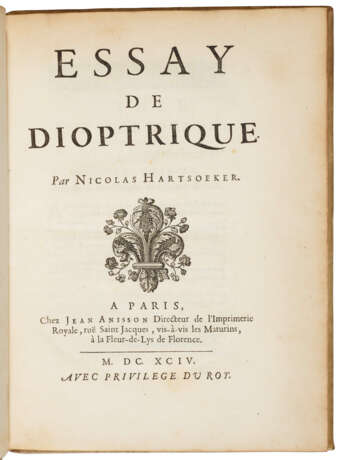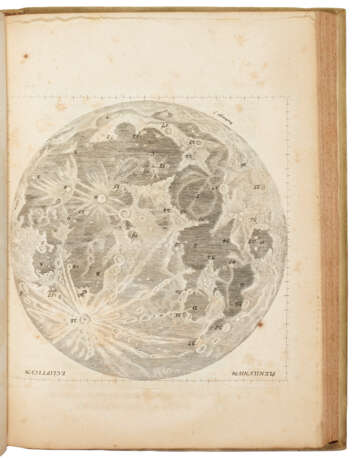ID 1360881
Lot 165 | Essay de Dioptrique
Estimate value
$ 2 500 – 3 500
First edition, rare, of Hartsoeker's first and most important work, in which he reviewed the principles of optics as far as they were known by the end of the 17th century. In addition to the physics of light and the physiology of vision, the book also treats in great detail techniques for the production of lenses for microscopes and telescopes. “Hartsoeker was always interested in optical instruments. He claimed to have developed a method of making small glass globules for microscopes, though his priority in this is doubted. He definitely made lenses of different focal lengths, some of which survive; one lens is said to have had a focal length of 600 feet. He made a number of instruments, not just optical instruments, for the Paris observatory. He constructed a burning glass of great size” (Galileo Project). The Essay also documents many observations Hartsoeker made with these instruments. Like Leeuwenhoek, Malpighi and others, Hartsoeker was a preformationist at a time when explanations of animal reproduction were a confused blend of Aristotelian theory, religious orthodoxy, and pure speculation. Towards the end of the book, on p. 230, he presented a picture of a little preformed human figure in the head of a spermatozoon. This picture has since become famous and more than a little notorious as an example of observations biased by theoretical prejudice. Hartsoeker's reputation has been forever linked to this picture and if his name appears today at all, he is usually held up as an example of a scientist who saw what he wanted to see. That was not, in fact, the case. In the text accompanying this famous picture he says: "si l'on pouvoit voir le petit animal au travers de la peau qui le cache, nous le verrions peut-etre comme cette figure le represente, sinon que la tete seroit peut-etre plus grande a proportion du reste du corps, qu'on ne l'a deffinee ici," i.e., if one's instruments were good enough, here is a suggestion of what one might see. Rare at auction: ABPC/RBH record only two copies in the past 35 years.
Born in Gouda, “Hartsoeker (1656-1725) was the son of Christiaan Hartsoeker, an evangelical minister, and Anna van der Mey. Although his father wished him to study theology, Hartsoeker preferred science; he secretly learned mathematics and lens grinding. Most sources suggest that he may have studied anatomy and philosophy at the University of Leiden in 1674; a letter from Constantijn Huygens to his brother Christiaan, however, refers to him as having had no higher education, so it is possible that he was largely self-educated in his chosen fields. It is known that by 1672 he had visited Leeuwenhoek and that in 1678 he accompanied Christiaan Huygens to Paris, where he met some of the French scientists and worked for a time at the Paris observatory. In his correspondence with Christiaan Huygens from about this period, Hartsoeker claimed to have invented the technique of making small globules of glass for use as lenses for microscopes, but it is more probable that priority in this belongs to Johann Hudde” (DSB).
“What distinguished Hartsoeker from other opticians was how candid he was about his lens craft and other technical inventions. Unlike Van Leeuwenhoek and the Campani brothers who warily shrouded their lens making methods, Hartsoeker did not keep trade secrets. In fact, his treatise on dioptrics explained in great detail what kind of glass to use, how best to grind lenses, and how to configure them most effectively. Even before his Essay de dioptrique came out in 1694, he shared with Huygens his idea of the simple microscope. He then collaborated with Huygens and Rømer on the design that was eventually published in the Journal des Sçavans in 1678. Only when Huygens appropriated Hartsoeker’s design of the simple microscope and passed it off as his own in the Journal des Sçavans, did Hartsoeker react with indignation. He wanted authorial credit for his invention. But when he began manufacturing telescope lenses, he continued to share his techniques and lenses with Huygens and others at the Academy … To some extent, it appears he deliberately capitalized on transparency when he first asked Huygens to be his benefactor. After the debacle with Huygens in 1678, he conducted himself more prudently. He learnt to protect his ideas and inventions in print” (Abou-Nemeh, pp. 9-10).
“In this treatise [i.e., the Essay], Hartsoeker not only explained how to work lenses but also made some natural philosophical claims on generation. For instance, he argued for pre-formation based on his observations with a microscope. The theory stipulated that parts of an organism, for example the fly, were already present in miniature forms in the maggot and merely grew as the organism further developed. The way in which he did this shows nicely how his philosophical hypotheses complemented his observations. For many years he had been observing the sperm of quadrupeds and human beings, which he thought resembled tadpoles." Ever since he had made these observations, he realized that birds, flies and butterflies, were born out of these “worms which enclose them inside and hide them from our view.” No doubt the idea of pre-formation influenced Hartsoeker’s observations. For instance, be believed “that each worm that one sees in the semen of birds encloses actually a male or female [organism] of the same species” as the parent. He presupposed “the same thing of the … [little animals] that there are found in the semen of men and quadrupeds.” Namely, “each animalcule contains and for the moment conceals … either a male or female animal from the same species.”
“By 1692, Huygens was curious about Hartsoeker’s philosophical ideas, all the while anticipating controversy. Huygens and Marquis de L’Hôpital remained in the know about Hartsoeker’s optical and philosophical ideas throughout the 1690s … During this time, Hartsoeker persistently tried to convince Huygens of his method for grinding telescopic lenses with long focal lengths. Hartsoeker’s lens making method and accompanying system of the world eventually resulted in the Essay de dioptrique, in which he advertised for the first time all the aforementioned observations and suppositions. Christiaan Huygens, his brother Constantijn, L’Hôpital and other savants eagerly awaited the publication of the treatise. They expected it to contain details of Hartsoeker’s microscopes and, more importantly, his lens making method. L’Hôpital received the treatise with mixed feelings: on the one hand he was thrilled about its possible novelties; but on the other hand, he reacted indignantly to the ideas it contained. Although the book dealt with optics and lens manufacture, it also offered Hartsoeker’s microscopical observations and ideas on generation. L’Hôpital and Huygens had looked forward to Hartsoeker’s lens-making secrets with bated breath, but they did not expect him to publish his ideas on natural philosophy in the book as well … In the eyes of Huygens and L’Hôpital, [Hartsoeker] was a skilled, educated craftsman who made a living by grinding lenses for the Academy and not yet a full-fledged philosopher who could make knowledge claims about nature. What set the two men apart from Hartsoeker and his ilk even further was the importance they granted mathematics” (ibid., pp. 16-19).
Of Hartsoeker’s lenses, two known to be by his hand are preserved, one signed "Nicolaas Hartsoeker, pro Academia Ludg. Batav: Parisiorum 1688" in the museum of natural history in Leiden, and the other in the museum of the University of Utrecht. It is known, however, that he made three telescopes for the Utrecht observatory at the time of Pieter van Musschenbroek’s arrival in 1723.
“Hartsoeker was elected a foreign member of the Académie des Sciences in 1699 and was later also a member of the Berlin Royal Society. His work may be said to have been more honored in France than in his native Holland” (DSB). Bierens de Haan, 1925; British Optical Association Library I, 91; Hirsch III, 77; Poggendorff I, 1026; Wellcome II, 217. See Abou-Nemeh, "The Natural Philosopher and the Microscope: Nicolas Hartsoeker Unravels Nature's 'Admirable Œconomy'”, History of Science 51 (2015), pp. 1-32.
Quarto (258 x 186). Woodcut text illustrations, engraved lunar plan by Duchange facing p.179 (some spotting in second half of text, one leaf with short marginal tear and small loss). Contemporary vellum, titles on spine.
| Address of auction |
CHRISTIE'S 20 Rockefeller Plaza 10020 New York USA | ||||||||||||||
|---|---|---|---|---|---|---|---|---|---|---|---|---|---|---|---|
| Preview |
| ||||||||||||||
| Phone | +1 212 636 2000 | ||||||||||||||
| Fax | +1 212 636 4930 | ||||||||||||||
| Conditions of purchase | Conditions of purchase | ||||||||||||||
| Shipping |
Postal service Courier service pickup by yourself | ||||||||||||||
| Payment methods |
Wire Transfer | ||||||||||||||
| Business hours | Business hours
|




